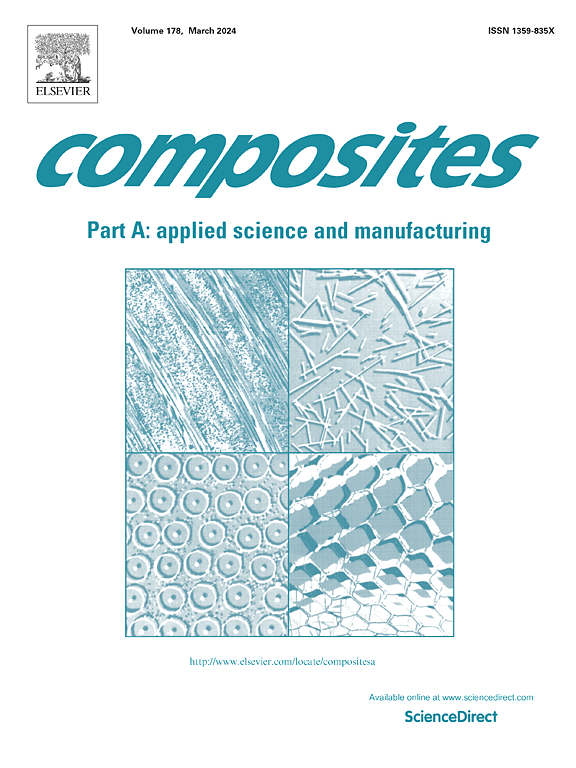厚连续纤维复合材料抗压强度的估计:量化初始纤维错位的作用
IF 8.1
2区 材料科学
Q1 ENGINEERING, MANUFACTURING
Composites Part A: Applied Science and Manufacturing
Pub Date : 2025-04-29
DOI:10.1016/j.compositesa.2025.108950
引用次数: 0
摘要
本文对连续纤维复合材料的抗压强度进行了研究。这些材料包括近十种不同的纤维/基体对,四种环氧基热固性树脂系统,三种不同的碳纤维和三家制造商。从厚层压板(每对10个样品)的弯曲测试中获得的实验值与分析压缩破坏准则进行了比较。后一种模型结合了工程设计和机械贡献的易用性,包括材料(层的非线性剪切行为),制造(初始纤维错位)和结构效应(加载,层的邻域)。利用光纤不对准频率分布的标准偏差,将实验值与估估值进行比较,结果令人满意或非常好。对一对的比较产生了不太有利的结果,在两个不同的制造商之间观察到更大的差异。纤维错位的空间分布提供了证据,在某些情况下,单一值可能不足以准确表征压缩破坏中缺陷的作用。本文章由计算机程序翻译,如有差异,请以英文原文为准。

Estimation of compressive strength in thick continuous fibre composites: Quantifying the role of initial fibre misalignment
The present study investigates the compressive strength of continuous fibre composites. These materials comprise almost ten different fibre/matrix pairs with four epoxy-based thermoset resin systems, three different carbon fibres and three manufacturers. The experimental values obtained from flexural testing on thick laminates (with 10 samples for each pair) are compared to an analytical compressive failure criterion. This latter model incorporates ease of use in engineering design and mechanistic contributions, including material (non-linear shear behaviour of the ply), manufacturing (initial fibre misalignment) and structural effect (loading, neighbourhood of ply). A comparison between the experimental and estimated values, using the standard deviation of the frequency distribution of fibre misalignment, demonstrates a satisfactory or excellent outcome. The comparison for a pair produced less favourable results, with greater discrepancies observed between two different manufacturers. The spatial distribution of fibre misalignment provides evidence that, in certain instances, a single value may be insufficient for accurately characterising the role of defects in compressive failure.
求助全文
通过发布文献求助,成功后即可免费获取论文全文。
去求助
来源期刊

Composites Part A: Applied Science and Manufacturing
工程技术-材料科学:复合
CiteScore
15.20
自引率
5.70%
发文量
492
审稿时长
30 days
期刊介绍:
Composites Part A: Applied Science and Manufacturing is a comprehensive journal that publishes original research papers, review articles, case studies, short communications, and letters covering various aspects of composite materials science and technology. This includes fibrous and particulate reinforcements in polymeric, metallic, and ceramic matrices, as well as 'natural' composites like wood and biological materials. The journal addresses topics such as properties, design, and manufacture of reinforcing fibers and particles, novel architectures and concepts, multifunctional composites, advancements in fabrication and processing, manufacturing science, process modeling, experimental mechanics, microstructural characterization, interfaces, prediction and measurement of mechanical, physical, and chemical behavior, and performance in service. Additionally, articles on economic and commercial aspects, design, and case studies are welcomed. All submissions undergo rigorous peer review to ensure they contribute significantly and innovatively, maintaining high standards for content and presentation. The editorial team aims to expedite the review process for prompt publication.
 求助内容:
求助内容: 应助结果提醒方式:
应助结果提醒方式:


